The Tevinter Imperium is the longest existing country in Thedas and is ruled by a powerful magocracy. The leaders of the Imperium are called magisters, and are led by the Imperial Archon.
In ancient times, the Imperium's power was unrivaled and its borders stretched in almost the entirety of the continent. In modern times, Tevinter is only a shadow of its former self in both size and power, however it is still a considerable power in the north.[1]
Culture
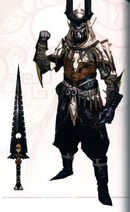
Armored Tevinter mage[2]
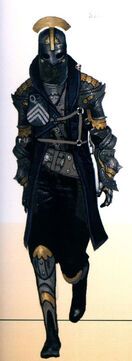
Altus mage[3]
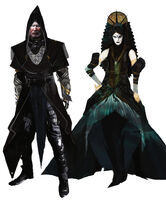
Tevinter noble dress[4]
Tevinter society is notoriously decadent. Ambition and magical ability are the hallmarks of its ruling elite, the magisters. The ancient magister lords ruled the Imperium in the Circles of Magi (before their modern incarnation), maintaining a tight hold over its people through the power to infiltrate their dreams using blood magic. Though blood magic is now banned in the Imperium, mages who practice it are quietly acknowledged as the most proficient dream-walkers and diviners.[5] The ban is really only paid lip service to; even the most devout mages in Tevinter know at least the basics.
The centuries-long war with the Qunari has taxed the Imperium significantly as resources are strained, with hundreds of refugees fleeing to the capital of Minrathous, the splendor of which is chafing greatly everywhere outside the spires that house the Imperium's Circles of Magi.[6]
The strata of Tevinter society encompasses three unique levels. All common citizens of the Imperium who are non-mages are considered part of the Soporati social class. This is a mainly human class which is allowed to own property and serve in Tevinter's military but they have no real power in the nation's governance and are unable to attain a higher rank in the Imperial Chantry than mother or father. Often they are found to be merchants. However, when a Soporati family produces a mage child it allows them entrance into the Laetans class and thus a higher social standing. In general, the Soporati and ruling mage classes exist in a state of tension due to the inequality of their standing in the nation.[3]
The next highest social level is that of Laetans, who are mages born into families that had up to that point shown no magical ability or who have been mages for generations but have no link to the higher Altus or Dreamer class. One third of the Archons throughout history have been Laetans.[3]
Altus mages are reckoned to be descendents of the Dreamers or magisters who possessed the ability to speak to the Old Gods in the Fade. The Old Gods are no longer objects of worship but the descendents of these powerful mages are still held in esteem and often are the most high-ranking mages in the Imperium; indeed the majority of magisters are Altus. Interestingly, there was a time in which these Altus mages were scorned for their seeming part in creating the Blights as the corruption of the Golden City transformed these mages into the first darkspawn. As a result, many such mages were slain during the period of Transfiguration when the Imperium became Andrastian. Since then, the Altus mages have returned to the upper echelon of Tevinter society.[3]
It is still legal for elves and humans and even Qunari[7] to be sold into slavery in Tevinter, a fact which allowed many elves from Ferelden to be sent to the Imperium during Teyrn Loghain's regency.[8][9] People may also choose to sell themselves into slavery to provide for their families. Slave revolts have been a common occurrence throughout history. Kirkwall was once the center of the Tevinter slave trade.[10] Dwarves are thus far not known to be kept as slaves in the Imperium, presumably due to their upstanding relations they held with them for millenia as well as for their fundamental importance in providing the Imperium with lyrium.
Slaves can only legally be set free before a judge, with the owner present to formally state the slaves have been granted freedom, or by the owner's will upon his or her death. These emancipated slaves are known as Liberati, a subclass with limited rights and are not considered citizens. Liberati can join a Circle of Magi or serve as an apprentice in trade. Liberati may also own property, but cannot join the military or have a say in governance.[11]
The Imperial Chantry is the main religious organization in Tevinter, replacing the abandoned worship of the Old Gods. It is more accepting of magic and allows men to join the priesthood.[12]
History

Heraldry of the Tevinter Imperium[13]
When humans first came to mainland Thedas, several tribes spread across Thedas, but it was the Tevinters, centered on the port-city of Minrathous, who became the most prolific.[14] The land was at first ruled by a dynasty of kings.[15] Circles of Magi formed in Tevinter cities as closed societies of mages, presumably to train and study their talents. They formed a council of their most talented mages, the Court of Magisters, which convened in Minrathous and decided the mandate of magic in the kingdom. In -1195 Ancient (0 TE), the premier magister lord of the Tevinter Dynasty,[16] Archon Darinius, took power as its first Archon and founded the Imperium, establishing the magisters as its aristocracy.[15] Darinius was the first human to successfully ally with the dwarves of Kal-Sharok and traded extensively with them.[17] A body of dwarven representatives titled "Ambassadoria" was established during that time to advise the Tevinter leaders and manage trade relations between the Imperium and the dwarven kingdoms. The Archon Thalsian, one of the first magisters, claimed to have contacted the Old God Dumat to learn blood magic, which he used to declare himself the ruler of an empire. Thalsian established temples to worship dragons, which became a symbol of power within the Imperium. He created the "Altus" as the ruling class, also known as "The Magisters", while his pupils formed the noble houses that ruled the empire for millennia.[18]
Although humans had coexisted with elves for a time, hostilities soon arose when the elves retreated from human contact. This led the Imperium to declare war on 214 TE. Six years later, the magisters invaded Arlathan, the elven homeland, and destroyed it by sinking the city to the ground with blood magic. Elven survivors were enslaved. From them, the magisters learned to use lyrium to enter the Fade, developing magical talent that soon dominated the nation's infrastructure.[14]

Tevinter landscape[3]
During its expansion, the Imperium conquered much of the land of Thedas, as far south as Ferelden and east as Rivain, subjugating the local tribes throughout with brutal force.[19] It commissioned the construction of the Imperial Highway to connect all lands under their rule together for the purpose of trade, but the fall of the Imperium meant the project was never completed.[20] In 620-640 TE, a large civil war erupted when the two most influential magisters warred for the vacant Archon's throne, threatening to split the empire. Even after order was restored, it marked the decline of the Imperium's golden age.[14]
In 800 TE, in a misguided attempt at apotheosis, a group of magisters sacrificed hundreds of slaves and used up two-thirds of the lyrium in the entire empire to physically enter the Fade using blood magic, returning as the first Darkspawn.[21] The Archdemon Dumat led the First Blight for nearly two hundred years, ravaging the empire and shattering its power. Civil unrest added to complications until the newly founded Grey Wardens finally defeated the Darkspawn.[22]
Their vulnerabilities exposed to the world, the severely weakened Imperium suffered the first Exalted Marches by the escaped slave Andraste and her husband Maferath who brought a barbarian army from Ferelden north to destroy the empire in 1020 TE. Slave revolts by elves enamored of Andraste's campaign exploded in cities everywhere, compounding the threat of the encroaching Fereldan armies. Finally the rebellion was put down and Andraste was publicly executed with her generals four years later.[19] In 1035 TE, Archon Hessarian, the ruler at the time of Andraste's revolt, formally converted to the faith himself and revealed Maferath's betrayal.[19]
In 1050-1120 TE, Rivain's war for independence from the Imperium begins, and distracts the Empire from reconquering the Free Marches. Eastern cities of the Free Marches rally to help Rivaini, and with the Battle of Temerin in 1117 TE, the Imperium abandons Rivain.[14]
With the founding of the Chantry in 1195 TE, Andrastian cults gained momentum around the world. The ruling magisters of Tevinter lost significant influence as they were penned into the restrictive Circles of Magi. Though southern Tevinter had split completely, the north remained intact. The magisters eventually surrendered to the Chantry, but only on their own terms.[23]
In 3:87 Towers, the Imperium split from the Andrastian Chantry and formed its own Imperial Chantry under a mage, Divine Valhail.[12] The Black Age and Exalted Age saw several Exalted Marches ordered against the Tevinter Imperium by the White Divine when tensions between the Orlesian and Imperial Chantries grew heated.[14]
In 6:30 Steel, Thedas was first attacked by the Qunari, and much of the Imperium was conquered in the conflicts. Determined to retake its lost territories, the Imperial Chantry declares the New Exalted Marches alongside the Orlesian Chantry long into the Storm Age (7:25–7:85). The Imperium did not take part in the Llomerryn Accords, an armistice which ended the war with the Qunari, as other human nations did, and as such the Tevinters and the Qunari are in a state of constant war as both struggle for dominance of northern Thedas, currently warring over the island of Seheron.[14]
In 7:34 Storm, political power has seemed to shift back to the magisters, as the new Archon Nomaran was elected directly from the Circle of Magi, abolishing laws that prohibited mages from participating in government.[12]
Politics

In Tevinter, temples to Old Gods became Circles of Magi.[24]
The Tevinter Imperium is still governed by powerful magic-users through a form of magocracy. It is almost universally reviled by other nations. Its nobility is known to be over-indulgent, and slavery is still practiced. The Imperium is the center of the black market, smuggling (including the harboring of mage fugitives from other lands) and the slave trade. Tevinter would crumble without slaves, given that it is the only way to support their economy. History shows how deeply committed they are to the practice; when an archon once outlawed it [slavery], the archon was quickly assassinated. Though slave rebellion occur frequently, the Imperial Senate unites in the face of "sedition" to suppress them. Though merely a shadow of its former glory, the Imperium is still a very powerful nation with considerable military might. It would turn on the southern nations were it not diverted by the constant wars with the Qunari.[5]
The Imperium draws a variety of soldiers from its territories to form an impressive army. Most noted throughout Thedas, however, is the use of elephant mounts that have been imported into Tevinter for centuries through the coastal colonies near the northwestern jungles. As well, Minrathous is famously protected by a trio of gigantic war golems purchased from the dwarves known as the Juggernauts.[5]
The Imperium's capital is Minrathous, at the northern end of the Imperial Highway. Tevinter has its own versions of the Chantry and Circles of Magi, both led by a male Divine, unofficially known as the Black Divine; his authority, and indeed the existence of the Imperial Chantry, is not recognized by the Chantry in Orlais. Likewise, the Imperial Chantry refuses to recognize the authority of the Orlesian Chantry and its "White Divine."[12] The Chantry calendar is in use everywhere except the Imperium, although the empire used it briefly when it was introduced.[25]
Magisters are members of the Senate and constantly compete with their fellows to rise into a higher position on the council, though they come together to put down slave rebellions, which they view as sedition. Their legislative body is called "The Magisterium". Raising one's position on the Senate can be achieved through wealth, magical prowess and/or support by fellow Senators but almost always requires relying on forbidden magic.[26] There are various means by which an enterprising mage may enter this august company. Each of the seven Circles within Tevinter selects a magister for the Magisterium, and this mage is often an older Senior Enchanter but never a First Enchanter as they are not eligible for a seat. Each of the grand clerics of the Imperial Chantry and the Divine himself hold a seat as well. A mage may also inherit a seat from a magister rather than earn it through magical ability or station within the Chantry. A final means by which a mage enters the Magisterium is by being appointed directly by the Archon, which is a power the Archon may exercise at any time.[27]
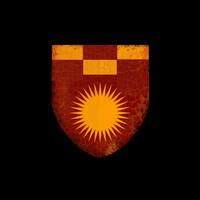
Imperial Chantry heraldry
The Archon is the true ruler of Tevinter and the magic he wields gives him a god-given authority over others, whether that god is one of the Old Gods or the Maker.[27] As noted above he may appoint magisters to the Magisterium at any time and has final say on any laws under consideration. The role of Archon is generally an inherited one and oftentimes these men are relatives or perhaps the apprentices of the previous Archon. In the event that an Archon passes without an appointed heir, the Magisterium steps in and names the next ruler provided he is not already part of the Magisterium or a member of the Chantry. Prior to the Black Age, however, the Archon had been allowed to be a magister or hold rank in the Imperial Chantry.[27]
Relations with the dwarves
Tevinter has enjoyed a long and fruitful alliance with the dwarven empire. The lyrium trade is the primary reason for their close alliance, and the magic-centric Imperium is mainly dependent on Orzammar to meet its immense demand.[28] Dwarves also provided the Imperium with golems, the most notable of which are the Juggernauts which protect Minrathous. Except the trade alliance, it is also known that the dwarves helped Tevinter during the Fourth Blight by lifting the siege of Marnas Pell and they received many accolades of the ruling Archon, one dwarf even became a Paragon.[29]
Many surface dwarves live in the Imperium, not considered citizens but rather foreign dignitaries, even if their houses have existed in the Imperium for ages. The Tevinter Imperium hosts numerous dwarven embassies, since the days of Archon Darinius and his alliance with the founding kings of the dwarven empire, Orseck Garal and Endrin Stonehammer. There are dwarven embassies in every major city, much like dwarven settlements in other countries in Thedas. However Tevinter dwarves have their own branch of government, the Ambassadoria, unlike dwarves in other countries. Ambassadoria representatives are elected by the dwarves to advise the Archon and the Magisterium.[28] The Ambassadoria is more of a lobbying group than a parliament.
Dwarven embassies in Minrathous, Neromenian, and Qarinus are entirely underground and are considered by dwarves to reside within the Stone, allowing those in the embassy to retain their caste. Some dwarves serving in Tevinter embassies never leave these underground fastnesses. No dwarves are known to be kept as slaves in the Imperium, presumably due to their fundamental importance to the Imperium in providing lyrium.
Despite this close alliance, there are two known cases in which some of the dwarves secretly breached this pact. The first was with providing safe harbor in Cadash Thaig for the ancient elves who were fleeing after the destruction of Arlathan. The dwarves of Kal-Sharok were informed of this so they attacked Cadash thaig and killed everyone in order to hide all the evidence from the Imperium.[30] The second occassion was when Amaranthine was held by the Avvars. The Imperium at that time were trying to conquer Ferelden and the Avvars secretly traded with the dwarves beneath Amaranthine.[31]
Geography
Cities
A Tevinter city

Example of Tevinter architecture[32]

A Tevinter building with dragon imagery[28]
- Asariel
- Carastes
- Marnas Pell [note]
- Marothius
- Minrathous - Capital
- Neromenian
- Perivantium
- Qarinus
- Teraevyn[33]
- Vol Dorma
- Vyrantium
Regions
- Eyes of Nocen
- The High Reaches
- The Hundred Pillars
- The Silent Plains
- Valarian Fields
- Arlathan Forest
Fortresses
Imperial language
Tevene is the official language of the Imperium,[34] Several runes bear Tevinter symbols, some of them old.
- Alluvin valla kal[35]
- Avanna: Hello.[36]
- Benefaris[37]
- Falgard: dwarf[38]
- Fasta vass: A swear word.[39]
- Festis bei umo canavarum: You will be the death of me.[40]
- Kevesh[41]
- Manaveris Dracona: Long live the Dragons.[42]
- Na via lerno victoria: Only the living know victory.[43]
- Venhedis: A swear word.[39]
- Somniari: a Dreamer, a special kind of mage who can shape the Fade.[44]
- Vishante kaffas: One of the reactions Fenris gives when accepting Orana as a slave. It's mostly likely a curse but the exact translation was not given.[36][35]
In the second example, the (-l) is the genitive, or possessive, marker. (-ud) is an accusative, or direct object, marker. There are 2 allomorphs: (-d) and (-ud) based upon epenthesis to avoid consonant clusters. Stacking of these affixes is an attested pattern in some languages. The suffix (-ev) is an imperative, or command, marker.
The suffix (-e) is a second-person agreement marker. English has a sort of "vestigial" agreement system, especially in the stronger old forms of high-frequency verbs like "be". Consider: I "am" but you "are" and he "is". Or in some dialects of course: I "be", you "be", we "be" etc. English word order has rendered ambiguity of role assignment almost a non-risk, so we don't really need agreement. The language above, however, has it; the (-e) tells you that the subject of the verb is 2nd person ("you").
Ancient Tevene
Ancient Tevene is the ancient and dead language of Tevinter Imperium. The annums (annual holidays) in the Thedosian calendar use a high name from Ancient Tevene, and a low name (Trade tongue).[45]
Notable people with Tevinter origins
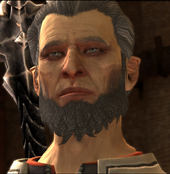
Danarius, a Tevinter magister
- For a complete list, see Category:Tevinters.
- Aurelian Titus
- Caladrius
- Corin
- Corypheus
- Danarius
- Devera
- Devon
- Eleni Zinovia
- Fenris
- Hadriana
- Hessarian
- Maevaris Tilani
- Orana
- Parthalan
- Tallis
- Varania
- Vasilia
Notes
- The city of "Marnas Pell" is named in an older map of Thedas as "Marnus Pell". However this is considered as inaccurate since in Dragon Age: The Stolen Throne[48] as well as in a newer map[49] it is mentioned as "Marnas Pell".
- The Imperial Highway spans from Minrathous to Vol Dorma and then southeast until one branch ends in Perivantium and another expands into Nevarra.
Trivia
- Writer David Gaider has stated that the Tevinter Imperium is loosely based on the real-world Roman Empire, especially in its later Byzantine period.[50]
- The names of Tevinter social classes (Soporati, Laetans and Altus) are Latin words meaning "sleeping," "rejoicing, happy" and "high, noble, proud" respectively.
Codex entries
![]() Codex entry: The Tevinter Imperium
Codex entry: The Tevinter Imperium
![]() Codex entry: The Imperial Chantry
Codex entry: The Imperial Chantry
![]() Codex entry: Tevinter: The Magisters
Codex entry: Tevinter: The Magisters
![]() Codex entry: Slavery in the Tevinter Imperium
Codex entry: Slavery in the Tevinter Imperium
References
|
| ||||||||||||||||||||||||||||||||||||||||||||||||||||||||||||||||||||||||||||||||
